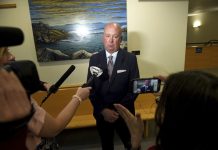LONDON (AP) — King Charles III’s decision to be open about his cancer diagnosis has helped the new monarch connect with the people of Britain and strengthened the monarchy in the year since his dazzling coronation at Westminster Abbey.
Charles has used his illness to highlight the need for early diagnosis and treatment, showing leadership at a time of personal hardship. And in the process, people have begun to see him as a more flesh-and-blood character who faces the same challenges as them, not just an archetype of wealth and privilege.
“Ultimately, the great leveler is health,” said Anna Whitelock, a professor of the history of the monarchy at City University, London. “And the fact is, the royal family, like so many other families, are coping with a cancer diagnosis. And I think that has … taken the energy out of big challenges to the king.’’
Questions still remain. Can a 1,000-year-old inherited monarchy represent the people of modern Britain? How will the institution address concerns about its links to empire and slavery? Should the monarchy be replaced with an elected head of state?
But for now, at least, those issues have been largely set aside as the 75-year-old king undergoes treatment for an undisclosed type of cancer.
Of all the things experts expected the royal family to face in the year following Charles’ coronation, the events of the last five months took Britain by surprise.
First, Charles was treated for an enlarged prostate, then he revealed his cancer diagnosis. That was followed quickly by the announcement that the Princess of Wales, Prince William’s wife, Kate, also had cancer.
Both retreated from public duties to focus on their health.William followed suit so he could support his wife and the couple’s three young children.
It was not just the septuagenarian monarch who was ill, but the much younger future queen. Her spouse needed to help out. Suddenly the royal family seemed much more vulnerable, more human.
With three senior royals out of action, the Windsors were stretched thin as they tried to keep up with the perpetual whirl of ceremonial appearances, awards presentations and ribbon cuttings that make up the life of a modern royal.
Into the breach stepped, of all people, Queen Camilla.
Once seen as the scourge of the House of Windsor because of her role in the breakup of Charles’ marriage to the late Princess Diana, Camilla emerged as one of the monarchy’s most prominent emissaries. Increasing her schedule of appearances, the queen played a crucial role in keeping the royal family in the public eye.
Wherever she went, royal fans offered get well cards and words of encouragement for Charles and Kate.
In many ways, the story of Charles’ first year since the coronation is about the rise of Camilla and how effective she’s been in representing the king, Whitelock said.
“The crowds reaching out to her has actually been quite remarkable,” she said. “So I think this first year has very much been the reign of Charles and Camilla in a way that we would never have imagined.”
Together, they helped create a year of stability for the monarchy, despite predictions from some critics that the death of Queen Elizabeth II would usher in an era of change.
That’s not to say Charles is free from troubles, many in his own family.
The king’s relationship with his younger son was strained even before Prince Harry and his wife Meghan ditched royal duties and moved to California in 2020. But the publication early last year of Harry’s bombshell memoir, “Spare,’’ deepened the rift with allegations about the unintentional racism of the royal family and sweetheart deals with the tabloid press.
And then there is Charles’ brother Prince Andrew, whose links to the late sex offender Jeffrey Epstein continue to cause headaches for the king. Just last month, Netflix dropped a full-length movie about the disastrous 2019 interview in which Andrew tried to justify his relationship with Epstein.
But throughout the last year, Charles worked to increase openness about the workings of the monarchy, continued to speak out on environmental issues and promoted interfaith dialogue, said George Gross, a royal historian at King’s College London.
Then came the king’s decision to publicize his health problems to demonstrate the benefits of early intervention in a country where cancer survival rates lag behind those in many other wealthy nations.
“Out of adversity, he’s managed to turn it around. It’s wrong to say he’s taken advantage of it, because it’s a disastrous situation to be in, and anyone with a cancer diagnosis will be very worried, very concerned,” Gross said. “But it has been this way that, as a head of state, he’s been able to do good with a very simple message, and I think that’s an extraordinary thing.”
Charles underscored his message last week when he began his return to public-facing duties with a visit to a cancer-care center.
Touring the University College Hospital Macmillan Cancer Centre in central London, the king sat with Lesley Woodbridge, a 63-year-old cancer patient, and held her hand as chemotherapy drugs dripped slowly into her arm.
“It’s always a bit of a shock, isn’t it, when they tell you?” he said, adding: “I’ve got to have my treatment this afternoon as well.”
It’s the kind of personal connection Britons don’t usually expect from the royals, who are known more for reserve than emotion.
After the king announced his diagnosis, Cancer Research UK recorded a 33% increase in visits to its website as people sought information about the signs of cancer, said Michelle Mitchell, chief executive of the charity.
That may have saved lives. And it connected people to the king.
Mitchell said she was struck by how very personal the king’s visit to the cancer center was.
Patients willingly told their cancer stories to Charles and Camilla, and the royal couple responded with intimate details of their own journey, she said.
“I observed not just empathy, but real compassion,’’ Mitchell said. “And overall, the atmosphere of the day was one of hope — but hope, I think, framed with the importance of research bringing greater progress.”
Source: post





